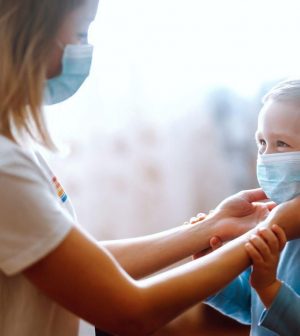- Understanding the Connection Between Anxiety and Depression
- How Daily Prunes Can Influence Cholesterol and Inflammation
- When to Take B12 for Better Absorption and Energy
- Epsom Salts: Health Benefits and Uses
- See What Saffron Can Do for Sleep and Heart Health
- 6 Common Mistakes to Avoid Before Your Physical
- Can Sweating Really Help You Beat a Cold?
- Strengthening Your Relationship: Practical Strategies
- Skip Storing This Everyday Product in the Fridge Door
- Green Tea + B3 Pairing May Boost Brain Health
Face Masks Don’t Hide Emotions From Kids: Study

For children, masks don’t mask the emotions of others, a new study shows.
It included nearly 300 children, ages 3-6, who were shown 90 pictures featuring actors who expressed joy, sadness or anger. In half of the pictures, the actors wore face masks.
In most cases, the children correctly identified the actors’ emotions whether they were wearing a mask or not, according to the study published Nov. 15 in the journal JAMA Pediatrics.
Overall rates of successfully reading emotions were more than 67% when the actors wore masks and more than 70% when they didn’t wear masks. Older children had higher success rates. About a quarter of preschoolers had greater difficulty distinguishing sadness from anger and about 21% sometimes confused joy for anger or sadness.
“Actual face masks depicted in static pictures were significantly associated with emotion recognition in healthy preschool children, although differences were small and effect sizes were weak,” the researchers from University Hospital Lausanne in Switzerland wrote.
The findings challenge concerns raised by some that the use of face masks in schools may harm younger children’s development.
“Even with masks being worn, little kids can probably still make reasonable inferences about other people’s emotions,” Ashley Ruba, a developmental psychology expert in the Child Emotion Lab at University of Wisconsin-Madison who has made similar findings during the pandemic, told CNN.
“I like to point out that the face isn’t the most important way we communicate our emotions, it is only one way. We also use tone of voice, we have body posture, we have other kinds of contextual clues that kids and adults can use to figure out how people are feeling,” Ruba said.
More information
Visit the U.S. Centers for Disease Control and Prevention for more on masks.
SOURCE: JAMA Network Open, Nov. 15, 2021; CNN
Source: HealthDay
Copyright © 2026 HealthDay. All rights reserved.










